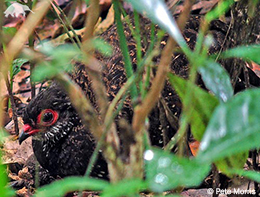About
The Nahan’s Francolin or Nahan’s Partridge has evolved cryptic, black and brown plumage, which helps camouflage the bird against the forest floor.
Despite these adaptations, the species is still vulnerable to hunting and egg collection. These activities occur on a small scale in Uganda and at unknown levels in the Democratic Republic of Congo. However, the clearance of forest for timber, charcoal and agriculture is the greatest threat to this species. This is particularly damaging as the species is thought to favour a rare combination of dense canopy and understorey, but sparse forest floor vegetation. Nests are often located on the ground in the shelter of large tree buttresses, which are frequently targeted by loggers. Numbers of birds are declining and the Nahan’s Francolin is classified as Endangered. It may be that Naharn’s francolin is one of only two species of New World Quails in Africa, though its exact relationship to the Old World Quails remains a debated subject.
- Order: Galliformes
- Family: Odontophoridae
- Population: 50,000-99,999
- Trend: decreasing
- Size: 23-26 cm
EDGE Score
Distribution
Found in the northeast of the Democratic Republic of the Congo and western parts of Uganda.
Habitat and Ecology
This species’ inhabit marshy or riverine primary forest occurring at low altitudes. Studies suggest the bird requires dense understorey growth as feeding habitat, dense canopy growth for breeding and roosting, but sparse forest floor vegetation. This combination of layers occurs infrequently in rainforests. They are omnivorous, feeding on invertebrates, plant material such as seeds and bulbs.
